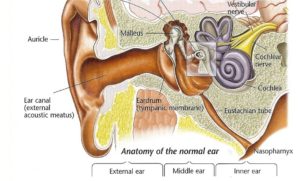The Function of the Ear
Essentially the function of the ears is to receive, amplify and convert sound (a pressure wave), into a neural impulse (an electric signal) that is sent to auditory cortex (the part of the brain that processes these signals into what we actually hear).
The external ear is made up of the pinna (auricle) and the external auditory canal (ear canal).
The middle ear is made up of the tympanic membrane (ear drum) and the ossicles (the 3 bones of hearing). These are the malleus, incus and stapes.

The functions of the middle ear are:
Impedence matching: this is transference of energy from the air of the middle ear to the inner ear fluid. This occurs through three major mechanisms: a hydraulic lever, ossicular lever, and catenary lever. The hydraulic lever concentrates acoustic energy at the oval window and results from the 17- to 20-fold difference in vibratory surface of the tympanic membrane compared with the smaller area of the stapes footplate. This is thought to be the main impedance matching mechanism. The ossicular lever results from the long axis of the malleus being 1.3 times the length of the long process of the incus. A smaller contribution is made by the catenary lever. Both the outward convexity of the eardrum and radial orientation of collagen fibres in the tympanic membrane lead to a twofold amplification of sound pressure onto the umbo. These unique characteristics of the tympanic membrane also protect the inner ear from static pressure variations while remaining sensitive to small pressure changes. An overall 20- to 30-dB sound pressure gain is thus produced by the impedance matching function of the middle ear: sound energy gain transferred by the middle ear is frequency dependent. Below 1 kHz the gain averages 23 dB and is relatively flat with a peak of 26 to 27 dB at 0.9 kHz. Gain decreases by 8 to 9 dB per octave above 1 kHz. A final modification is imparted by the resonance of the mastoid air cells. A peak resonance at 3 kHz leads to a 5- to 6-dB decrease in sound transmission at that frequency.
Transmission through the incudo-stapedial joint is more efficient at lower frequencies.
The resonant frequency is when mass reactance and elastic reactance are equal. Of the middle ear this = 800-900Hz
Mechanical protection. Both from an intact tympanic membrane and providing an air cushion which prevents aspiration from nasopharynx (the back of the nose).
Essential to the proper working of the middle ear is the function of the Eustachian tube, a tube connecting the middle ear to the nasopharynx.
